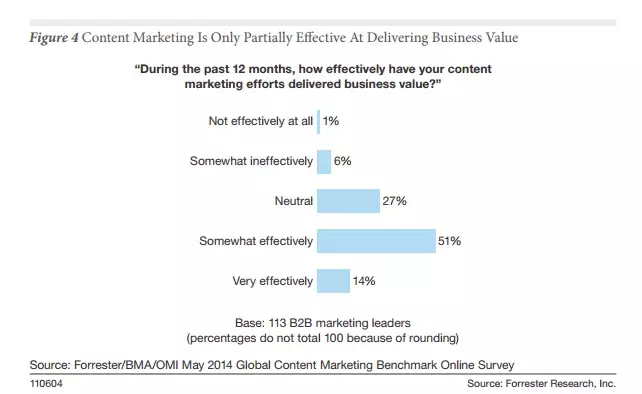Despite widespread increases in content-marketing budgets, b-to-b marketers are still struggling to translate their content-marketing efforts into actual businesses results, according to a new study conducted by Forrester in conjunction with the Business Marketing Association and the Online Marketing Institute.
Just over half – 51% – of marketers told Forrester their content marketing efforts are only somewhat effective; 27% rated the strategy as neutral; 6% said it was somewhat ineffective at delivering value; 1% said it was not effective at all.
“Marketers are still struggling to figure this out,” says Forrester VP Laura Ramos, who wrote the study. “They’re doing a lot of things around content marketing, but they fully admit they don’t think it’s going that well.”‘
But they aren’t turning tail. In fact, as part of a separate b-to-b survey earlier late last year 75% of respondents told Ad Age they would increase their content-marketing budgets in 2014. And the Forrester study found that 51% of b-to-b marketers rated their content marketing efforts as “very mature.” But with only 14% said these efforts are very effective at delivering business value, b-to-b marketers seem to be encountering a problem of execution, not of will. 113 b-to-b marketing executives responded to the Forrester survey.
Still learning
In an interview, Ramos said that online distribution channels are still baffling to many b-to-b marketers, who have yet to grasp how to message through them. “Some of the tools that we use – email marketing and marketing automation tools – give us a lot more power to reach out to customers, but we have to produce content to feed those tools and we’re not taking the steps to think about if this is the best content we can put out there,” she says.
One tip she offered: b-to-b businesses should speak about the business issues their buyers are facing, and what can be done address those issues. After looking at 30 b-to-b websites, Ramos says 80% of the companies were primarily focused on themselves, with information on products and features but little in regard to the issues their customers might be facing.
An emphasis on volume over quality may be behind the problem. “In this mad rush to create all of this content, they’re not really thinking about how to make the content better or more compelling or more interesting. They’re just producing,” Ramos says. With volume needed to feed the beast, many marketers revert to talking about what they know and feel comfortable discussing: themselves.
Staffing Issues
Another key factor behind b-to-b marketers’ content-marketing problem may be staffing. Many marketers, Ramos says, come into the field via functions such as sales, product design and business development. These marketers come from places where communication is important, but where being provocative, intriguing and informational isn’t as valued as it is in fields such as journalism, for instance. She also says that hiring journalists can help improve content marketing efforts, while also pointing to the need for elite marketing educational institutions.
The study also found that within 72% of b-to-b marketing organizations, less than half the staff plays a primary content role. This is another misstep, says Ramos, arguing that everyone in today’s marketing organizations should have content as part of the job, and that people brought on in senior content-marketing roles “should raise the level of all the marketing people inside the organization so they’re all better writers and storytellers and able to speak in the voice of the customer”.
When asked whether content produced by businesses will ever generate the hoped-for results, Ramos says she believes it will. “It has to be solved and it may be solvable through attrition.” “Those organizations who are better adept at understanding their customers, obsessing over them, speaking in their voice and literally doing the kind of content that will help win new customers, serve the customers they have, and retain the customers they have – those will be the ones that stay in business.”


 Back
Back 









